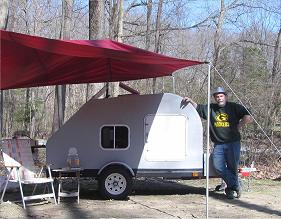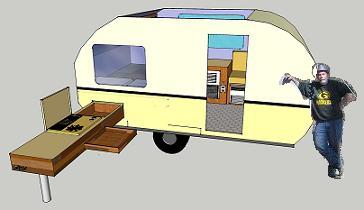I have been doing a lot of reading, and it seems everyone is using epoxy resin. I plan on painting the finished trailer with hardened automotive acrylic enamel, so the resin I use will have no exposure to the elements. I have used polyester resins on wood on several speaker enclosures I have built (I have two young sons) and never had a delamination issue.
I have access to FREE polyester resin as I sell the stuff and have a vendor willing to supply me, but the epoxy resin will cost me in the area of $65.00 per mixed gallon.
My other question.. to cloth or not to cloth.. just thinking about sanding time here, not really an expense issue.. comments please.
Polyester resin vs Epoxy Resin
19 posts
• Page 1 of 2 • 1, 2
Polyester resin vs Epoxy Resin
-- Paul --
Build Thread
http://www.tnttt.com/viewtopic.php?t=35787
2nd Build Thread
http://www.tnttt.com/viewtopic.php?f=50&t=47901


 http://www.teartime.com
http://www.teartime.com
Build Thread
http://www.tnttt.com/viewtopic.php?t=35787
2nd Build Thread
http://www.tnttt.com/viewtopic.php?f=50&t=47901
-

parnold - Donating Member
- Posts: 2344
- Images: 302
- Joined: Mon Feb 08, 2010 4:49 pm
- Location: Northwest New Jersey
Ok parnold - I'll Chime in - the last two builds _ i used polyester resin instead of CPES and epoxy. The first was in 3/8 ply and it did real well. The second build I went to a thinner ply, 5mm luan. I fiberglassed All the joints and sealed the whole thing three thin coats of polyester resin. after about a year - it still looks great. My design is Winter Warrior, so the parts get movement every time I set up or take down - and I've camped in both extremes: hot and cold, with not a mention of bubbling or cracking!
Check out the build link below for more details
Check out the build link below for more details
-

starleen2 - 5th Teardrop Club
- Posts: 16272
- Images: 224
- Joined: Sat May 12, 2007 8:26 pm
- Location: Pea Ridge ,AR

 domestic plywood will check even when encapsulated with resin. Adding a layer of glass will help to stop it from occurring
domestic plywood will check even when encapsulated with resin. Adding a layer of glass will help to stop it from occurring